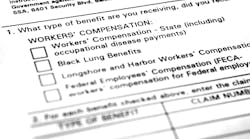Workers’ Compensation is defined as insurance that pays benefits and/or medical care to employees who are injured on the job, or who become ill as a direct result of their job.
Key things to know as an employer:
- Workers’ Compensation is an employer-sponsored insurance, and it is mandatory in most states.
- The benefits covered by Workers’ Compensation include medical expenses, lost wages, disability benefits, ongoing care, and death benefits.
A Workers’ Compensation Audit examines a company's payroll records and class code to determine whether the full required premium payment was made, based on the estimated premium payments that had been determined at the start of the policy. The Audit examines the records for a stated period. The examination period can be based on the annual renewal of the policy or upon termination of a policy.
How it All Starts
The Audit begins with a letter from the Workers’ Compensation Insurance Company, which is mailed to the company’s address and contact on file. It is addressed to the Policy Holder (which is the company being audited). The letter contains the following references: the policy number, audit number, and audit period. There are two additional sections: Payroll Verification Options and Records Required.
The Records Required section of the letter will provide details on the requested documents. The Payroll Verification Options section of the letter informs the Policy Holder of the options available to them regarding the submission of the requested documents. Some of the options include onsite visits, Virtual Payroll Verification, and Records Upload. Some states offer several options, though other states provide just one. For the "Virtual Payroll Verification" option, an online meeting will be scheduled using a platform such as Microsoft Teams or Zoom. For the "Records Upload" option, the Policy Holder or their representative will upload the requested documents to a specified website, as directed.
In the Records Required section of the notice letter, the list of documents is presented. The customary list includes the following:
- Payroll records, Payroll returns (such as 941s, 1099s, 1096s, W2s, W3s and State- specific payroll returns)
- General Ledger, Tax Returns
- Certificate of Insurance for Subcontractors
- Contracts, Bills, and Invoices (for materials, labor, and services)
The letter will close with the name of the audit along with the contact information for the Auditor. As you might surmise, it is crucial to respond to the letter in a timely manner.
Responding to the Audit
As soon as the letter is received and reviewed by the Policy Holder and/or their representative, we recommend contacting the Auditor to acknowledge receipt of the letter. At this time the Auditor should also be informed of the date on which the requested documents will be submitted, and the method that will be used to submit them.
Failure to respond to a few notices can result in fines being automatically assessed.
If the information being submitted is complete, choosing the payroll upload option is best. However, if the information is incomplete and needs explanation, the Virtual Meeting option might be a better choice.
What the Auditor is Looking For During the Audit
- Confirmation that the work being performed by the company correlates with the industry code on which the policy was based (which would be stated in the invoices presented).
- Comparison of the estimated payroll figures on which the policy premium was based versus the actual payroll wages. The actual payroll amount will be stated in the payroll tax filings, W2s and W3s. Adjustments will have to be paid, based on the time period.
- Confirmation that any contractors or subcontractors on the Policy Holder's payroll are actual contractors who possess their own Workers’ Compensation Policy. If this is not the case, the Policy Holder may be liable.
- Tax returns are used to verify the amounts presented by the Policy Holder.
Any changes to the estimates made to calculate the policy premium may cause a change in the premium, either a decrease or increase. The Policy Holder will receive a letter with the Auditor’s changes, to which they can either agree or dispute. If they dispute the changes, they must do so by providing documentation to support their position.
Recommendations
One way to minimize the changes to a workers compensation premium which can occur as a result of an audit is to get a policy where the premium is paid when the payroll is processed. The premium for the workers compensation policy will be assessed based on the payroll for the period. This minimizes any changes to the premium as a result of the audit because the payments will be made on the actual payroll figures.
If a change is made to the services offered by a business, the Policy Holder should inform their insurance agent, so that the industry codes used to calculate the premium can be appropriately adjusted.
Ask all contractors and subcontractors to provide a copy of their Workers Compensation Insurance Policy. Ensure the policy is active and covers the industry codes for the services each contractor provides.
Remember, preparing for a Workers’ Compensation Audit starts from the moment a Policy Holder begins looking for a quote. Trying to cut costs at the start may cost way more later. If you would like more information, reach out to us at lekmanagementinc.com/contact/.
*Research sources: The Hartford, Forbes
Founder and CEO of LEK Management Inc., Lynn Karam has two decades of experience in finance, operations, and strategic planning. Karam is an Enrolled Agent authorized by the United States Department of the Treasury to represent clients who are undergoing an audit and to negotiate with the IRS on her clients’ behalf. Her success rate in resolving even the most challenging of IRS scenarios has become the cornerstone of her success. As CEO, Karam uses her financial expertise to establish sustainable strategies that result in significant business growth for her clients.


